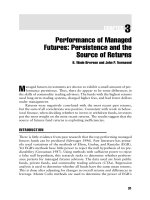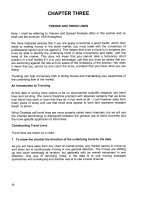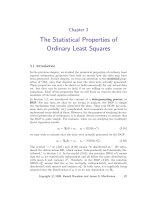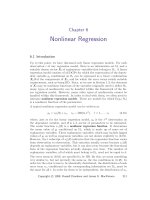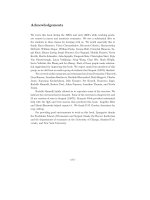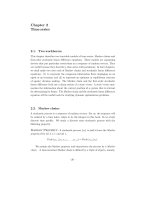Recursive macroeconomic theory, Thomas Sargent 2nd Ed - Chapter 3 docx
Bạn đang xem bản rút gọn của tài liệu. Xem và tải ngay bản đầy đủ của tài liệu tại đây (141.94 KB, 11 trang )
Chapter 3
Dynamic Programming
This chapter introduces basic ideas and methods of dynamic programming.
1
It sets out the basic elements of a recursive optimization problem, describes
the functional equation (the Bellman equation), presents three methods for
solving the Bellman equation, and gives the Benveniste-Scheinkman formula for
the derivative of the optimal value function. Let’s dive in.
3.1. Sequential problems
Let β ∈ (0, 1) be a discount factor. We want to choose an infinite sequence of
“controls” {u
t
}
∞
t=0
to maximize
∞
t=0
β
t
r (x
t
,u
t
) , (3.1.1)
subject to x
t+1
= g(x
t
,u
t
), with x
0
given. We assume that r(x
t
,u
t
)isacon-
cave function and that the set {(x
t+1
,x
t
):x
t+1
≤ g(x
t
,u
t
),u
t
∈ R
k
} is convex
and compact. Dynamic programming seeks a time-invariant policy function h
mapping the state x
t
into the control u
t
, such that the sequence {u
s
}
∞
s=0
generated by iterating the two functions
u
t
= h (x
t
)
x
t+1
= g (x
t
,u
t
) ,
(3.1.2)
starting from initial condition x
0
at t = 0 solves the original problem. A
solution in the form of equations (3.1.2) is said to be recursive. To find the
policy function h we need to know another function V (x)thatexpressesthe
1
This chapter is written in the hope of getting the reader to start using the
methods quickly. We hope to promote demand for further and more rigorous
study of the subject. In particular see Bertsekas (1976), Bertsekas and Shreve
(1978), Stokey and Lucas (with Prescott) (1989), Bellman (1957), and Chow
(1981). This chapter covers much of the same material as Sargent (1987b,
chapter 1).
– 82 –
Sequential problems 83
optimal value of the original problem, starting from an arbitrary initial condition
x ∈ X .Thisiscalledthevalue function. In particular, define
V (x
0
)= max
{u
s
}
∞
s=0
∞
t=0
β
t
r (x
t
,u
t
) , (3.1.3)
where again the maximization is subject to x
t+1
= g(x
t
,u
t
), with x
0
given. Of
course, we cannot possibly expect to know V (x
0
) until after we have solved the
problem, but let’s proceed on faith. If we knew V (x
0
), then the policy function
h could be computed by solving for each x ∈ X the problem
max
u
{r (x, u)+βV (˜x)}, (3.1.4)
where the maximization is subject to ˜x = g(x, u)withx given, and ˜x denotes
the state next period. Thus, we have exchanged the original problem of finding
an infinite sequence of controls that maximizes expression (3.1.1) for the prob-
lem of finding the optimal value function V (x) and a function h that solves
the continuum of maximum problems (3.1.4)—one maximum problem for each
value of x. This exchange doesn’t look like progress, but we shall see that it
often is.
Our task has become jointly to solve for V (x),h(x), which are linked by
the Bellman equation
V (x)=max
u
{r (x, u)+βV [g (x, u)]}. (3.1.5)
The maximizer of the right side of equation (3.1.5) is a policy function h(x)
that satisfies
V (x)=r [x, h (x)] + βV {g [x, h (x)]}. (3.1.6)
Equation (3.1.5) or (3.1.6) is a functional equation to be solved for the pair of
unknown functions V (x),h(x).
Methods for solving the Bellman equation are based on mathematical struc-
tures that vary in their details depending on the precise nature of the functions
r and g .
2
All of these structures contain versions of the following four findings.
Under various particular assumptions about r and g, it turns out that
2
There are alternative sets of conditions that make the maximization (3.1.4)
well behaved. One set of conditions is as follows: (1) r is concave and bounded,
and (2) the constraint set generated by g is convex and compact, that is, the set
84 Dynamic Programming
1. The functional equation (3.1.5) has a unique strictly concave solution.
2. This solution is approached in the limit as j →∞by iterations on
V
j+1
(x)=max
u
{r (x, u)+βV
j
(˜x)}, (3.1.7)
subject to ˜x = g(x, u),x given, starting from any bounded and continuous
initial V
0
.
3. There is a unique and time invariant optimal policy of the form u
t
= h(x
t
),
where h is chosen to maximize the right side of (3.1.5).
3
4. Off corners, the limiting value function V is differentiable with
V
(x)=
∂r
∂x
[x, h (x)] + β
∂g
∂x
[x, h (x)] V
{g [x, h (x)]}. (3.1.8)
This is a version of a formula of Benveniste and Scheinkman (1979). We
often encounter settings in which the transition law can be formulated so
that the state x does not appear in it, so that
∂g
∂x
=0,whichmakes
equation (3.1.8) become
V
(x)=
∂r
∂x
[x, h (x)] . (3.1.9)
At this point, we describe three broad computational strategies that apply
in various contexts.
of {(x
t+1
,x
t
):x
t+1
≤ g(x
t
,u
t
)} for admissible u
t
is convex and compact. See
Stokey, Lucas, and Prescott (1989), and Bertsekas (1976) for further details of
convergence results. See Benveniste and Scheinkman (1979) and Stokey, Lucas,
and Prescott (1989) for the results on differentiability of the value function. In
an appendix on functional analysis, chapter A, we describe the mathematics for
one standard set of assumptions about (r, g). In chapter 5, we describe it for
another set of assumptions about (r, g).
3
The time invariance of the policy function u
t
= h(x
t
) is very convenient
econometrically, because we can impose a single decision rule for all periods.
This lets us pool data across period to estimate the free parameters of the
return and transition functions that underlie the decision rule.
Sequential problems 85
3.1.1. Three computational methods
There are three main types of computational methods for solving dynamic pro-
grams. All aim to solve the functional equation (3.1.4).
Value function iteration. The first method proceeds by constructing a
sequence of value functions and associated policy functions. The sequence is
created by iterating on the following equation, starting from V
0
= 0, and con-
tinuing until V
j
has converged:
4
V
j+1
(x)=max
u
{r (x, u)+βV
j
(˜x)}, (3.1.10)
subject to ˜x = g(x, u),x given.
5
This method is called value function iteration
or iterating on the Bellman equation.
Guess and verify. A second method involves guessing and verifying a solution
V to equation (3.1.5). This method relies on the uniqueness of the solution to
the equation, but because it relies on luck in making a good guess, it is not
generally available.
Howard’s improvement algorithm. A third method, known as policy
function iteration or Howard’s improvement algorithm, consists of the following
steps:
1. Pick a feasible policy, u = h
0
(x), and compute the value associated with
operating forever with that policy:
V
h
j
(x)=
∞
t=0
β
t
r [x
t
,h
j
(x
t
)] ,
where x
t+1
= g[x
t
,h
j
(x
t
)], with j =0.
2. Generate a new policy u = h
j+1
(x) that solves the two-period problem
max
u
{r (x, u)+βV
h
j
[g (x, u)]},
for each x.
4
See the appendix on functional analysis for what it means for a sequence
of functions to converge.
5
A proof of the uniform convergence of iterations on equation (3.1.10) is
contained in the appendix on functional analysis, chapter A.
86 Dynamic Programming
3. Iterate over j to convergence on steps 1 and 2.
In the appendix on functional analysis, chapter A, we describe some con-
ditions under which the improvement algorithm converges to the solution of
Bellman’s equation. The method often converges faster than does value func-
tion iteration (e.g., see exercise 2.1 at the end of this chapter).
6
The policy
improvement algorithm is also a building block for the methods for studying
government policy to be described in chapter 22.
Each of these methods has its uses. Each is “easier said than done,” because
it is typically impossible analytically to compute even one iteration on equa-
tion (3.1.10). This fact thrusts us into the domain of computational methods
for approximating solutions: pencil and paper are insufficient. The following
chapter describes some computational methods that can be used for problems
that cannot be solved by hand. Here we shall describe the first of two special
types of problems for which analytical solutions can be obtained. It involves
Cobb-Douglas constraints and logarithmic preferences. Later in chapter 5, we
shall describe a specification with linear constraints and quadratic preferences.
For that special case, many analytic results are available. These two classes
have been important in economics as sources of examples and as inspirations for
approximations.
3.1.2. Cobb-Douglas transition, logarithmic preferences
Brock and Mirman (1972) used the following optimal growth example.
7
A
planner chooses sequences {c
t
,k
t+1
}
∞
t=0
to maximize
∞
t=0
β
t
ln (c
t
)
subject to a given value for k
0
and a transition law
k
t+1
+ c
t
= Ak
α
t
, (3.1.11)
6
The quickness of the policy improvement algorithm is linked to its being
an implementation of Newton’s method, which converges quadratically while
iteration on the Bellman equation converges at a linear rate. See chapter 4 and
the appendix on functional analysis, chapter A.
7
See also Levhari and Srinivasan (1969).
Sequential problems 87
where A>0,α ∈ (0, 1),β ∈ (0, 1).
This problem can be solved “by hand,” using any of our three methods. We
begin with iteration on the Bellman equation. Start with v
0
(k) = 0, and solve
the one-period problem: choose c to maximize ln(c) subject to c +
˜
k = Ak
α
.
The solution is evidently to set c = Ak
α
,
˜
k = 0, which produces an optimized
value v
1
(k)=lnA + α ln k . At the second step, we find c =
1
1+βα
Ak
α
,
˜
k =
βα
1+βα
Ak
α
,v
2
(k)=ln
A
1+αβ
+ β ln A + αβ ln
αβA
1+αβ
+ α(1 + αβ)lnk . Continuing,
and using the algebra of geometric series, gives the limiting policy functions
c =(1−βα)Ak
α
,
˜
k = βαAk
α
, and the value function v(k)=(1−β)
−1
{ln[A(1−
βα)] +
βα
1−βα
ln(Aβα)} +
α
1−βα
ln k .
Here is how the guess-and-verify method applies to this problem. Since we
already know the answer, we’ll guess a function of the correct form, but leave
its coefficients undetermined.
8
Thus, we make the guess
v (k)=E + F ln k, (3.1.12)
where E and F are undetermined constants. The left and right sides of equation
(3.1.12) must agree for all values of k . For this guess, the first-order necessary
condition for the maximum problem on the right side of equation (3.1.10) implies
the following formula for the optimal policy
˜
k = h(k), where
˜
k is next period’s
value and k is this period’s value of the capital stock:
˜
k =
βF
1+βF
Ak
α
. (3.1.13)
Substitute equation (3.1.13) into the Bellman equation and equate the result
to the right side of equation (3.1.12 ). Solving the resulting equation for E and
F gives F = α/(1 − αβ)andE =(1−β)
−1
[ln A(1 −αβ)+
βα
1−αβ
ln Aβα]. It
follows that
˜
k = βαAk
α
. (3.1.14)
Note that the term F = α/(1 − αβ) can be interpreted as a geometric sum
α[1 + αβ +(αβ)
2
+ ].
Equation (3.1.14) shows that the optimal policy is to have capital move
according to the difference equation k
t+1
= Aβαk
α
t
,orlnk
t+1
=lnAβα +
α ln k
t
.Thatα is less than 1 implies that k
t
converges as t approaches infinity
8
This is called the method of undetermined coefficients.
88 Dynamic Programming
for any positive initial value k
0
. The stationary point is given by the solution
of k
∞
= Aβαk
α
∞
,ork
α−1
∞
=(Aβα)
−1
.
3.1.3. Euler equations
In many problems, there is no unique way of defining states and controls, and
several alternative definitions lead to the same solution of the problem. Some-
times the states and controls can be defined in such a way that x
t
does not
appear in the transition equation, so that ∂g
t
/∂x
t
≡ 0. In this case, the first-
order condition for the problem on the right side of the Bellman equation in
conjunction with the Benveniste-Scheinkman formula implies
∂r
t
∂u
t
(x
t
,u
t
)+
∂g
t
∂u
t
(u
t
) ·
∂r
t+1
(x
t+1
,u
t+1
)
∂x
t+1
=0,x
t+1
= g
t
(u
t
) .
The first equation is called an Euler equation. Under circumstances in which
the second equation can be inverted to yield u
t
as a function of x
t+1
,usingthe
second equation to eliminate u
t
from the first equation produces a second-order
difference equation in x
t
, since eliminating u
t+1
brings in x
t+2
.
3.1.4. A sample Euler equation
As an example of an Euler equation, consider the Ramsey problem of choosing
{c
t
,k
t+1
}
∞
t=0
to maximize
∞
t=0
β
t
u(c
t
) subject to c
t
+ k
t+1
= f(k
t
), where k
0
is given and the one-period utility function satisfies u
(c) > 0,u
(c) < 0, lim
c
t
0
u
(c
t
)=∞;andwheref
(k) > 0,f
(k) < 0. Let the state be k and the control
be k
,wherek
denotes next period’s value of k . Substitute c = f(k) −k
into
the utility function and express the Bellman equation as
v (k)=max
˜
k
{u
f (k) −
˜
k
+ βv
˜
k
}. (3.1.15)
Application of the Benveniste-Scheinkman formula gives
v
(k)=u
f (k) −
˜
k
f
(k) . (3.1.16)
Notice that the first-order condition for the maximum problem on the right
side of equation (3.1.15) is −u
[f(k) −
˜
k]+βv
(
˜
k) = 0, which, using equation
Stochastic control problems 89
v(3.1.16), gives
u
f (k) −
˜
k
= βu
f
˜
k
−
ˆ
k
f
(k
) , (3.1.17)
where
ˆ
k denotes the “two-period-ahead” value of k.Equation(3.1.17) can be
expressed as
1=β
u
(c
t+1
)
u
(c
t
)
f
(k
t+1
) ,
an Euler equation that is exploited extensively in the theories of finance, growth,
and real business cycles.
3.2. Stochastic control problems
We now consider a modification of problem (3.1.1) to permit uncertainty. Es-
sentially, we add some well-placed shocks to the previous non-stochastic prob-
lem. So long as the shocks are either independently and identically distributed
or Markov, straightforward modifications of the method for handling the non-
stochastic problem will work.
Thus, we modify the transition equation and consider the problem of max-
imizing
E
0
∞
t=0
β
t
r (x
t
,u
t
) , 0 <β<1, (3.2.1)
subject to
x
t+1
= g (x
t
,u
t
,
t+1
) , (3.2.2)
with x
0
known and given at t =0,where
t
is a sequence of independently
and identically distributed random variables with cumulative probability distri-
bution function prob{
t
≤ e} = F(e) for all t; E
t
(y) denotes the mathematical
expectation of a random variable y , given information known at t.Attime
t, x
t
is assumed to be known, but x
t+j
,j ≥ 1isnotknownatt.Thatis,
t+1
is realized at (t +1), after u
t
has been chosen at t.Inproblem(3.2.1)–
(3.2.2), uncertainty is injected by assuming that x
t
follows a random difference
equation.
Problem (3.2.1)–(3.2.2) continues to have a recursive structure, stemming
jointly from the additive separability of the objective function (3.2.1) in pairs
90 Dynamic Programming
(x
t
,u
t
) and from the difference equation characterization of the transition law
(3.2.2). In particular, controls dated t affect returns r(x
s
,u
s
)fors ≥ t but
not earlier. This feature implies that dynamic programming methods remain
appropriate.
The problem is to maximize expression (3.2.1) subject to equation (3.2.2)
by choice of a “policy” or “contingency plan” u
t
= h(x
t
). The Bellman equation
(3.1.5) becomes
V (x)=max
u
{r (x, u)+βE [V [g (x, u, )] |x]}, (3.2.3)
where E{V [g(x, u, )]|x} =
V [g(x, u, )]dF ()andwhereV (x)istheoptimal
value of the problem starting from x at t =0. ThesolutionV (x)ofequation
(3.2.3) can be computed by iterating on
V
j+1
(x)=max
u
{r (x, u)+βE [V
j
[g (x, u, )] |x]}, (3.2.4)
starting from any bounded continuous initial V
0
. Under various particular regu-
larity conditions, there obtain versions of the same four properties listed earlier.
9
The first-order necessary condition for the problem on the right side of
equation (3.2.3) is
∂r (x, u)
∂u
+ βE
∂g
∂u
(x, u, ) V
[g (x, u, )] |x
=0,
which we obtained simply by differentiating the right side of equation (3.2.3),
passing the differentiation operation under the E (an integration) operator. Off
corners, the value function satisfies
V
(x)=
∂r
∂x
[x, h (x)] + βE
∂g
∂x
[x, h (x) ,] V
(g [x, h (x) ,]) |x
.
In the special case in which ∂g/∂x ≡ 0, the formula for V
(x) becomes
V
(x)=
∂r
∂x
[x, h (x)] .
Substituting this formula into the first-order necessary condition for the problem
gives the stochastic Euler equation
∂r
∂u
(x, u)+βE
∂g
∂u
(x, u, )
∂r
∂x
(˜x, ˜u) |x
=0,
9
See Stokey and Lucas (with Prescott) (1989), or the framework presented
in the appendix on functional analysis, chapter A.
Exercise 91
where tildes over x and u denote next-period values.
3.3. Concluding remarks
This chapter has put forward basic tools and findings: the Bellman equation
and several approaches to solving it; the Euler equation; and the Beneveniste-
Scheinkman formula. To appreciate and believe in the power of these tools
requires more words and more practice than we have yet supplied. In the next
several chapters, we put the basic tools to work in different contexts with par-
ticular specification of return and transition equations designed to render the
Bellman equation susceptible to further analysis and computation.
Exercise
Exercise 3.1 Howard’s policy iteration algorithm
Consider the Brock-Mirman problem: to maximize
E
0
∞
t=0
β
t
ln c
t
,
subject to c
t
+ k
t+1
≤ Ak
α
t
θ
t
, k
0
given, A>0, 1 >α>0, where {θ
t
} is
an i.i.d. sequence with ln θ
t
distributed according to a normal distribution with
mean zero and variance σ
2
.
Consider the following algorithm. Guess at a policy of the form k
t+1
=
h
0
(Ak
α
t
θ
t
) for any constant h
0
∈ (0, 1). Then form
J
0
(k
0
,θ
0
)=E
0
∞
t=0
β
t
ln (Ak
α
t
θ
t
− h
0
Ak
α
t
θ
t
) .
Next choose a new policy h
1
by maximizing
ln (Ak
α
θ −k
)+βEJ
0
(k
,θ
) ,
where k
= h
1
Ak
α
θ .Thenform
J
1
(k
0
,θ
0
)=E
0
∞
t=0
β
t
ln (Ak
α
t
θ
t
− h
1
Ak
α
t
θ
t
) .
92 Dynamic Programming
Continue iterating on this scheme until successive h
j
have converged.
Show that, for the present example, this algorithm converges to the optimal
policy function in one step.

